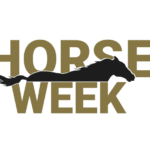September 12, 2008 — Other than a couple of superb performances, I was let down by the 2008 Olympic dressage freestyles. Maybe I’m becoming desensitized to freestyles like soldiers in war get desensitized to death. No, I don’t really believe that. I did still get goose bumps, just not enough of them.
I was too nervous for Ashley Holzer and Berna Pujals to feel anything else during their rides. Ashley recovered brilliantly after the little mess at the start. For some reason–maybe it was because they decided to give every rider exactly 60 seconds from the time they entered the stadium until the bell was rung (It’s the excuse I’ve heard for what happened to Solos Carex)–jury president Gotthilf Riexinger would stand up and lean toward the bell, usually ringing it right when Brian O’Connor decided he needed to announce something. Several riders didn’t hear it. Several looked at him, saw him standing and assumed they hadn’t heard it, even though he still hadn’t rung it.
There were a number of confusing moments for riders, but Ashley was the only one who went through the stress of hearing her music playing but not being able to enter because the well-trained and obedient gate girls hadn’t heard the bell. Another issue was that nearly everyone got ahead of his or her music, and of course I noticed it more with my clients than anyone else. No, Berna, don’t walk during your trot music. Ashley, just hang on one more stride to start the ones. Aw crap! All that waiting screwed up Poppy’s brain and he had a mistake. Watching my clients at the Olympics sounds like fun, but it gave me heart palpitations.
So, highlights? For me number one was Hans Peter Miderhoud. I thought the flower child music suited his horse, Nadine, to double goose-bump standard, and Hans Peter really rode to his music. I loved the way he used “for every season, turn, turn, turn” for the pirouettes–cool! Great arrangements and editing. Five stars.
Four stars to Steffen Peters, and I think five are in the near future, maybe at the World Cup Finals in Vegas next spring. He had very difficult choreography (in spite of what Riexinger said in his failed efforts to justify how Isabell Werth could have beaten him), and to see such a talented but green horse try so hard for his rider was one of the more inspiring moments of the night. I thought I was going to hate his music when I read what a mish mash it was: Vangelis, Rolling Stones and Men Without Hats. How can that sound like it comes from the same radio station? But it was all arranged (hats off to Terry Gallo) and played by the same group of musicians in Memphis–so even though we jumped from new age to bad-boy rock to androgynous ’80s, it worked. It really suited the horse, too.
I’m digging deep to find a third favorite here. Bonaparte was a very good boy for Heike Kemmer, but her surfer medley left me tepid. Alexandra Korelova’s pink piaffe machine Balagur looked tired of his tired old Broadway hits. I found Isabell Werth’s music puzzling, because it really never has a beat that does a thing for Satchmo’s gaits, and I hate that she caved to the judges when they told her that her “March With Me” was too risky with the vocals. These days, just about everyone has vocals creeping in somewhere. I don’t envy Anky van Grunsven’s job with her music. The transitions for movements like the tempi changes are so subtle as to be almost nonexistent. I admire the heck out of Wibi Soerjadi, the wonder-composer, but there is some magic missing from that one for me.
Gong! My very least favorite freestyles were by a couple of the early Scandinavians. “Elevator” and “ice cream truck” are descriptors that come to mind when I think of their syntho-pop programs. I recognized some of the songs, but I failed to place them because they sounded so unlike the originals. Not that it’s a bad thing to have a cool and different arrangement of a familiar song, but it shouldn’t sound like it was done on a computer using the keyboard for piano keys. A word of advice for those whose scores actually dipped below what they got in the Special: Don’t put things in your choreography that diminish the quality of your performance. No one likes dressage to look labored or impossible–well, except maybe the five “O” judges who gave Satchmo two 7s, two 8s and a 6.5 for harmony.
For complete Olympic dressage scores, go to www.fei.org. Read Nancy Jaffer’s on-the-scene coverage of the dressage freestyles.
Karen Robinson is an equine journalist and an international freestyle designer from Vancouver, British Columbia, Canada. Her freestyles have been performed at Dressage at Devon, the Pan American Games, World Cup Finals and Olympic Games. She is a frequent contributor to Dressage Today magazine. Her website is applausedressage.com.





